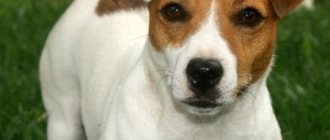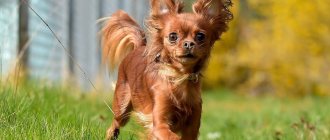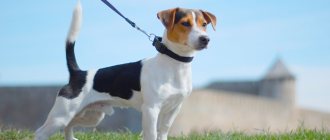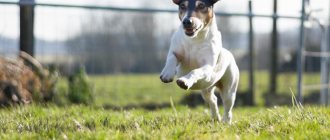The Russian Toy Terrier is a small, nimble, but timid dog.
It is distinguished by a small head with large, bulging eyes and large ears. Belongs to the decorative group.
There are two varieties of the breed - short-haired and long-haired.
We will talk about the long-haired variety in this article. You will learn about its characteristics, the specifics of care and nutrition, as well as how to choose the right purebred puppy.
Origin story
It is believed that the Toy Terrier was developed relatively recently, in the last century. But this is only true for the Russian Toy Terrier. The English breed dates back to the 18th century.
The first long-haired Russian Toy Terrier puppy was born on October 12, 1958 to short-haired parents.
The case did not go unnoticed; moreover, the breeders decided to consolidate this “trait”. The pet was matched with a friend who gave birth to exactly the same long-haired puppies. The experiment produced representatives of an interesting branch and gave rise to future breeding.
NOTE!
In 1988, a revision of the outdated standard for this breed was scheduled. In the new edition, the Russian Smooth-haired and Moscow Long-haired Toy Terriers were combined into one breed - the Russian Toy, which included both varieties.
So one puppy became the founder of a new variety among toy terriers.
Maintenance and care
The miniature Moscow Longhaired Toy Terrier is ideally suited for living in city apartments. It does not take up much space and does not require complex care. They need to be bathed at least twice a month using special shampoos. During the washing process, it is important to ensure that water does not get into the animal’s ears. It is advisable to comb your dog every other day. The best way to care for silky smooth fur is with a special brush, which you can buy at any pet store.
Also, owners of miniature dogs should not forget about regularly trimming their pets’ nails and wiping their ears. Long-haired toy terriers should be walked only during daylight hours, away from larger dogs and busy highways. Moreover, in the autumn and winter, before going outside, the baby will have to dress up in warm overalls that reliably protect from the cold. If desired, the puppy can be trained to use a tray or diaper so that he does not need to be taken out into the yard in cold weather.
Description of the breed
The Russian Toy Terrier is a small dog with an elegant build that easily compensates for its small size with arrogance and a predisposition to manipulate people.
Toy's ancestor is a true terrier, so the dog nips bad attitudes towards itself in the bud. The pet does not have a clear opinion regarding other animals and often becomes the initiator of conflicts, without thinking at all about the consequences.
Despite the fact that the breed is exclusively domestic, it is impossible to deprive Toy of walks and physical activity. With a lack of activity, the dog becomes irritable and capable of aggression, so it is important to give dogs the opportunity to “let off steam.”
Puppy cost
The price of toy terrier puppies depends on the pedigree. Bitches are usually more expensive. Long-haired ones are also slightly more expensive than smooth-haired pets. In general, prices range from $200 to $700.
You should choose a puppy of this breed from nurseries or breeders. It would be a great idea to visit exhibitions and dog breeding clubs. It is necessary to choose a toy terrier with a stud book and get to know its relatives. This is required to be confident in the pet’s genetic predispositions.
Expert opinion
Anna Abramenko
An avid dog lover. Experience in veterinary medicine since 2009.
Ask a Question
There is no point in looking for high-breed puppies on message boards. Professional nurseries have personal resources. If the publication is posted by breeders, then it should contain detailed information about breeds and nicknames.
A responsible owner does not sell unvaccinated toy terrier puppies until quarantine (2.5 months).
Character traits
This is a playful and affectionate dog that quickly becomes attached to its owner. However, the breed is susceptible to stress, which makes it difficult to have toy terriers in families with children. The dog does not have a calm and patient disposition, so it can bite the offender.
IMPORTANT!
Despite his height, he is self-confident. Small pets often manipulate their owners to achieve goals.
These dogs are often picky when it comes to feeding, encourage owners to pay attention to them in every possible way, and will not give up the desire to mark their territory, denoting real estate rights.
Nutrition
Feeding must be balanced . Dry food contains all the necessary microelements that a dog needs, but you must choose premium or luxury class. When feeding natural food, special vitamins must be given. Possible menu:
- Boiled chicken or other meat.
- Vegetables (boiled carrots, cauliflower or zucchini).
- They love to eat dried apricots.
- It will be beneficial for dogs to eat fish. It is recommended to give it once or twice a week.
- Free access to water should be 24 hours a day. The water must be changed at least once a day. It should be clean and cool.
- They will also not refuse treats. Dried trachea are suitable for them. They can be purchased at a specialty store or prepared in a drying chamber.
- For a treat, you can give a piece of apple, banana or cheese.
Prohibited products:
- Fatty meat (pork, duck).
- Roast.
- Spicy foods.
- Sweets and baked goods.
- Pasta.
- Bread.
- Raw meat.
Under no circumstances should food be given from the table . The dog quickly gets used to this and then he will not leave the table and will constantly ask for something tasty. Food that the dog has not finished eating must be immediately removed from the floor.
Accepted standard
The peculiarity of the breed is the compact size of the dog and thin bones. This is an elegant dog with long legs, whose weight does not exceed 3 kg, and the height at the withers barely reaches 28 cm.
Description of the breed standard :
- rounded head;
- prominent forehead;
- thin, triangular ears;
- weak cheekbones;
- a small nose, whose shade matches the color of the coat;
- square body format;
- Long neck;
- rounded loin and croup;
- legs are straight, with well-developed muscles;
- the hips are wide, but with weakly defined joints;
- the tail has a sickle shape, which is often docked;
- sexual characteristics are poorly expressed.
Expert opinion
Kozhevin Semyon Kirillovich
Expert dog handler.
A toy is a small pet with a small muzzle and large erect ears. This gives the impression that the pet is fragile, which is true, but only partly. In fact, the dog has well-developed muscles, and its body resembles a miniature Doberman. A distinctive feature of the long-haired Toy Terrier is the long locks and tassels that beautifully frame the ears. Smooth-haired toy terriers do not have this feature.
Characteristics of the Toy Terrier
Modern representatives of the Toy Terrier breed are small, long-legged dogs, curious, active, with an intelligent look. The animal is easy to train, but is not suitable for replacing service or hunting dogs.
The dog can be kept in an apartment and travel together.
The Toy Terrier's height is 20-28 cm, and its weight is 2-3 kg. The colors are black, blue, brown and tan, red, and has no spots, since this breed does not have a marble color.
The long-haired toy is distinguished by a small hairy coat (length - 3-5 cm), which requires daily care - combing.
Photos of colors
The most common colors:
- brown and tan;
- black and tan;
- lilac and tan;
- blue and tan;
- pale yellow;
- red with brown, black or without plaque.
The Russian Toy appreciates black, red, fawn and brown shades. Particular attention is paid to rich colors.
Advantages and disadvantages
Positive sides:
- cheerful;
- distrustful of strangers;
- get along well in an apartment;
- get along with family;
- highly trainable;
- do not require large amounts of food;
- They do well without long walks.
Negative:
- timid, aggressive, hysterical character;
- easily excitable;
- picky about feeding;
- susceptible to diseases;
- easily injured;
- often change roles in the owner-pet plan;
- freeze easily.
Life expectancy and health
The lifespan of these pets is reduced to 12-13 years, but this does not prevent dogs from overcoming the milestone at 15 years. However, much more often dogs die without living even half of their destined life.
Factors influencing the lifespan of a toy terrier:
- heredity;
- nutrition;
- care.
NOTE!
The breed has fragile bones, so dogs are prohibited from reaching peaks higher than 0.4 meters. Usually the limits of what is permissible are set by the ability of the dog itself, so it is not recommended to allow the pet onto a surface that it cannot jump to.
It is also advised to keep Toys away from large animals - dogs have no perception of their own growth, strength and potential.
These dogs also have a poorly developed sense of satiety, so it is important for owners to follow a diet and not indulge their pet. He can either become obese or lose weight.
In terms of teeth, it’s also ambiguous. As a rule, milk teeth are replaced by molars, but incidents occur in relation to teeth where the help of a veterinarian cannot be avoided.
Long-haired toy terriers are susceptible to diseases such as:
- diseases of internal organs;
- neurological diseases;
- problems with the musculoskeletal system;
- allergy;
- baldness;
- epilepsy.
Behavioral features
Representatives of this breed are unusually active and energetic. In character they are somewhat reminiscent of Jack Russell Terriers. Long-haired Toys are very impulsive and temperamental. They have a loud, ringing voice and use it for any reason. It is almost impossible to wean them from constant barking. These playful and affectionate animals are very loyal to their owners and get along well with other pets. At the same time, tiny dogs have a flexible psyche. They are very impressionable, fearful and prone to stress. We must not forget that obsessive attention from a person can provoke nerve problems in a dog.
Despite the fact that the Russian Longhaired Toy Terrier is friendly towards other pets, he will not refuse to chase someone else’s cat or birds around the yard. Moreover, he does it so recklessly that he does not hear the owner’s commands. He remains playful throughout his life and even in old age will happily run after a ball. Its tiny size does not prevent it from being suspicious of strangers and challenging larger dogs. Therefore, owners of cocky representatives of this breed need to be very careful while walking.
Basic rules of care
Despite the fact that this dog is long-haired, the Toy Terrier is not demanding in grooming. The owner only needs to use a comb or comb several times a week to prevent the formation of tangles.
You should bathe your pet no more often than once every 5-7 months and use a special shampoo for dogs. This is due to the fact that she has sensitive skin that is prone to dryness.
Grooming a pet
is a separate topic:
- the standard length of hair on the body is 3-5 cm;
- the fur adheres to the body, but does not hide the contours and curves;
- on the forelimbs the coat is shorter;
- the ears are covered with thick hair that covers the edges and tips.
To avoid diseases of the teeth and gums, weekly teeth brushing is required, but for this you purchase a special toothbrush and toothpaste.
Dog ears are affected by ear infections and ear mites, so regular inspection is recommended. Taking care of your pet also includes caring for the eyes, in the corners of which dirt accumulates. The eyes are examined and carefully cleaned of debris.
There are many toy terriers that are not able to sharpen their claws, so the responsibility is shifted to the owner, who is required to systematically trim them (once every 15-20 days). In this case, part of the claw is trimmed to avoid damage to the blood vessels.
Due to the weak coat and small body composition, the animal freezes easily, so in the cold season the pet is walked in overalls or a jacket.
Russian Toy: psyche, character
One of the reasons for the great popularity of long-haired Toys is their cheerful, easy-going and friendly attitude towards everything that happens around them. There is an opinion that decorative dogs are endowed with an evil and irreconcilable disposition, but Russian breeders paid great attention to the psyche of dogs, and received an affectionate and sociable breed.
Moscow Toy Terriers are highly trainable
Long-haired toy terriers get along well with children, become attached to all household members, and live peacefully with non-aggressive cats, dogs and other pets.
But, like all dogs, Moscow Toys have disadvantages. Firstly, these dogs are subtle psychologists, and if the owner overly pampers a miniature friend, he can “sit on the neck” - manipulate the owner, refuse food, begging for goodies or attention, bark, and mark in the house. To prevent this from happening, raising a toy terrier needs to be done from the first days of its appearance.
To raise a toy terrier, the owner and all family members must follow certain rules, while not skimping on affection and care. The puppy needs to immediately establish boundaries that will be unshakable for him. For example, if the owner forbids the dog to sit in a chair, then no one should ever allow this.
To prevent your toy from growing up capricious and disobedient, you need to take care of him.
Despite the fact that Toy Terriers are mini breeds, it would be a good idea to attend at least a few general training lessons with your dog, or invite a canine instructor for personal training. Even a miniature dog should know how to walk on a leash, understand basic commands and obey a person. In addition, the baby needs to be taught good manners - not to bark at passers-by, noise at the front door and other dogs.
Despite the fact that the size of a toy terrier allows him to live a “cat’s life”, that is, to be in the apartment all the time and even do toilet chores in the litter box, you cannot deprive the dog of the joy of walking and communicating with his own kind. Long-haired Toys are very active, enjoy physical exercise - walking, playing ball, jogging, and need daily walks. Otherwise, the dog will be fearful, due to the inability to splash out energy - capricious, intrusive and can spoil the owner’s things.
Your puppy needs plenty of toys
We should not forget that the ancestors of the breed were hunting terriers, and there is no need to devalue modern decorative babies. The Moscow Toy Terrier will not tolerate unceremonious treatment, will suffer from painful manipulations caused by children, and is capable of biting. They will not tolerate aggression from larger animals. Unfortunately, there are even cases of death of small dogs that fearlessly entered into a fight with a large dog that offended them.
What and how to feed?
First of all, the owner should decide on the type of feeding.
In terms of natural products, it is recommended to adhere to a balanced diet. It is important for a dog to have vitamins, minerals, fiber and protein in its food.
The diet should include:
- chicken by-products, fish and meat (15-30%), chopped beef is also suitable;
- porridge (30%);
- vegetables (20-25%).
Toys love cabbage, carrots, cucumbers and beets, and don’t mind eating pieces of banana, apple and pear.
It is not recommended to abuse fermented milk products (once every 3 days); pets also do not digest milk well.
Remember that dogs gain weight quickly, so watch their diet and how much food your pet consumes. And don’t let them take someone else’s food, much less pick something up from the street or at a party.
Prohibited products:
- spicy, fatty, bitter, salty and fried foods;
- sour cream and butter;
- smoked meats;
- nuts;
- sweets, baked goods;
- egg white;
- sausages;
- spices.
If the choice fell on industrial food, then toy terriers need to choose premium brands and higher. You shouldn't skimp on your dog's food - cheap food can cause health problems for your pet.
IMPORTANT!
Whatever type of food the owner chooses, at first it is advised to leave the dog with the diet to which the pet has already become accustomed. The introduction of a new diet is gradual, over 1.5-2 weeks, to avoid the development of food stress.
Price range
On average, for a long-haired toy terrier puppy without documents they will demand 12-17 thousand rubles, a puppy with a pedigree costs more - 30-50 thousand.
The cost is also affected by gender and color.
In toys, gender is weakly expressed, but this does not deprive the bitch of the ability to reproduce offspring, therefore the price of girls is higher than boys. Among the colors, blue and tan and lilac and tan are distinguished; red is cheaper.
The problem is that it is difficult to find a pet in the advertisements that will meet every breed standard. If the future owner is interested in the potential of the pet (for example, to participate in exhibitions), then the best solution would be to contact the nursery directly.
What do the puppies look like?
Long-haired puppies have hair that stands up, making the pet look thicker.
In childhood, Toy puppies are plump and remain so for the first 3-4 months of life. They stretch out with age, becoming slimmer.
How to choose your future pet?
Kennels sell puppies 40-45 days old. At this age, dogs have already erupted their milk teeth and the pets are ready to move.
Before purchasing, the animal is examined for skin diseases, inflammation, and rashes. When choosing a pet, it is advised to pay attention to the paws (without curvature) and the tummy (should not be large and inflated). Puppies are characterized by cheerfulness and activity, so look for a puppy with shiny eyes and fur.
There is reason to be wary if:
- the puppy is not allowed out of the crate during examination;
- there are signs of strabismus;
- the pet has bulging eyes;
- no passport;
- discharge from the nose, eyes.
Rules for choosing a puppy
Parameters by which a purebred toy terrier is selected:
- The weight of a three-month-old individual is at least 1-1.5 kg.
- The bite is scissor-shaped, and there should be 6 teeth between the canines on each jaw.
- A show pet is purchased at the age of 4 months.
- White spots on a Toy Terrier's body are not disqualifying, but are undesirable. Marble - tribal marriage. Long-haired puppies are characterized by feathering on their paws and ears.
- If your pet is inactive or shy, this may indicate a disease. It is better to repeat the visit and observe a second time, since activity and curiosity are inherent in this breed from an early age.
- Rash, bald spots, discharge, hot ears are bad signs for a toy terrier. There is no dandruff or redness in healthy pets.
- Particular attention should be paid to the gait and limbs of the terrier. Lameness is unacceptable.
- A puppy's timidity or angry mood is not a reason to refuse. Representatives of this breed love their owners, are cautious with strangers, and the potential buyer is not yet the owner. It is better to try to establish contact with the puppy and offer a treat.











